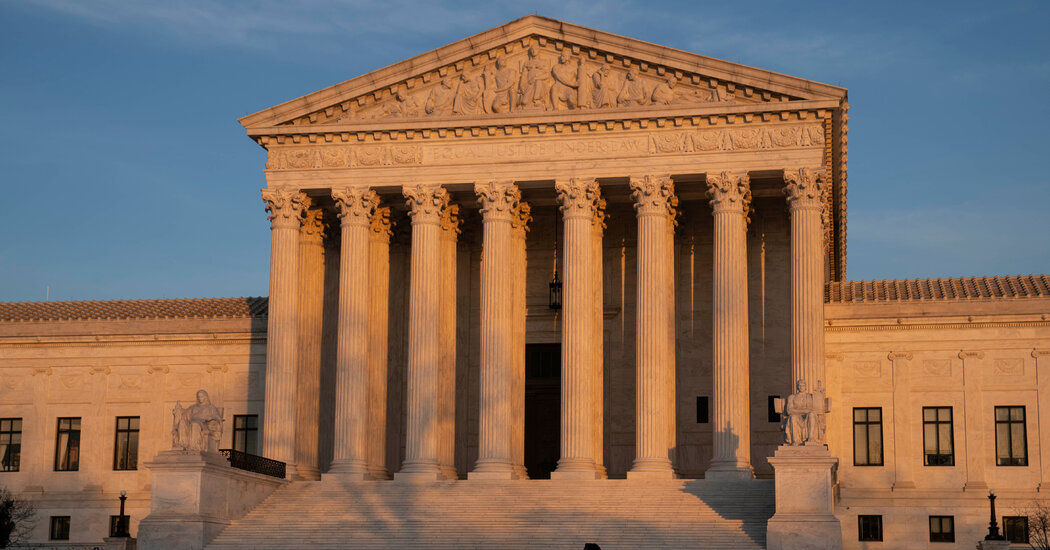
WASHINGTON — The Supreme Court on Monday reinstated an Alabama congressional map that a lower court had said diluted the power of Black voters, suggesting that the court was poised to become more skeptical of challenges to voting maps based on claims of race discrimination.
The vote was 5 to 4, with Chief Justice John G. Roberts Jr. joining the court’s three liberal members in dissent.
The Supreme Court’s brief order, which included no reasoning, was provisional, staying a lower court’s decision while the case moves forward. The justices said they would hear Alabama’s appeal of the lower court’s ruling, but they did not say when.
Both the stay and the decision to hear the case indicated that the court is open to weakening the role race may play in drawing voting districts for federal elections, setting up a major new test of the Voting Rights Act in a court that has gradually limited the reach of the law in other contexts.
The dispute in Alabama is part of a pitched redistricting battle playing out across the country, with Democrats and Republicans alike challenging electoral districts as unlawful gerrymanders. Those challenges have mostly been filed in state courts, meaning the Supreme Court is unlikely to intervene.
Civil rights leaders and some Democrats say the redistricting process often disadvantages growing minority communities. Republican state officials say the Constitution allows only a limited role for the consideration of race in drawing voting districts.
If the court follows its usual practices, it will schedule arguments in the Alabama case for the fall and issue a decision months later, meaning that the 2022 election would be conducted using the challenged map.
Alabama has seven congressional districts and its voting-age population is about 27 percent Black. In the challenged map, Black voters are in the majority in one district. The lower court, relying on the Voting Rights Act, had ordered the State Legislature to create a second district in which Black voters could elect a representative of their choice.
In a concurring opinion on Monday, Justice Brett M. Kavanaugh, joined by Justice Samuel A. Alito Jr., said that “the stay order does not make or signal any change to voting rights law.” It was necessary, he wrote, because the lower court had acted too soon before a coming election.
“When an election is close at hand, the rules of the road must be clear and settled,” Justice Kavanaugh wrote. “Late judicial tinkering with election laws can lead to disruption and to unanticipated and unfair consequences for candidates, political parties and voters, among others.”
What to Know About Redistricting and Gerrymandering
“It is one thing for a state on its own to toy with its election laws close to a state’s elections,” he wrote. “But it is quite another thing for a federal court to swoop in and redo a state’s election laws in the period close to an election.”
In dissent, Chief Justice Roberts said the lower court in the Alabama case had “properly applied existing law in an extensive opinion with no apparent errors for our correction.”
Still, he wrote, the Supreme Court’s precedents “have engendered considerable disagreement and uncertainty regarding the nature and contours of a vote dilution claim.”
The correct solution, the chief justice wrote, would have been to agree to hear the state’s appeal — but not to grant a stay in the meantime.
“The practical effect of this approach,” he wrote, “would be that the 2022 election would take place in accord with the judgment of the district court, but subsequent elections would be governed by this court’s decision on review.”
In a separate dissent, Justice Elena Kagan said the majority had gone badly astray.
“It does a disservice to the district court, which meticulously applied this court’s longstanding voting-rights precedent,” she wrote. “And most of all, it does a disservice to Black Alabamians who under that precedent have had their electoral power diminished — in violation of a law this court once knew to buttress all of American democracy.”
She added that the lower court had acted well before the next primary election, in late May, and the general election, in November.
“Alabama is not entitled to keep violating Black Alabamians’ voting rights just because the court’s order came down in the first month of an election year,” she wrote.
Justices Stephen G. Breyer and Sonia Sotomayor joined Justice Kagan’s dissent.
In earlier decisions, the Supreme Court effectively gutted Section 5 of the Voting Rights Act, which had required federal approval of changes to state and local voting laws in parts of the country with a history of racial discrimination, and cut back on Section 2 of the law, limiting the ability of minority groups to challenge voting restrictions.
The Alabama case also concerns Section 2, but in the context of redistricting.
Section 2 bars any voting procedure that “results in a denial or abridgment of the right of any citizen of the United States to vote on account of race.” That happens, the provision goes on, when, “based on the totality of circumstances,” racial minorities “have less opportunity than other members of the electorate to participate in the political process and to elect representatives of their choice.”
In November, Alabama’s Legislature, which is controlled by Republicans, redrew the state’s seven-district congressional map to take account of the 2020 census. It maintained a single district in which Black voters make up a majority.
How U.S. Redistricting Works
What is redistricting? It’s the redrawing of the boundaries of congressional and state legislative districts. It happens every 10 years, after the census, to reflect changes in population.
That district has long elected a Democrat, while the state’s other six districts are represented by Republicans.
After the map was challenged by Black voters and advocacy groups, a unanimous three-judge panel of the Federal District Court in Birmingham ruled last month that the Legislature should have fashioned a second district “in which Black voters either comprise a voting-age majority or something quite close to it.”
The unsigned decision was joined by Judge Stanley Marcus, who ordinarily sits on the U.S. Court of Appeals for the 11th Circuit, in Atlanta, and was appointed by President Bill Clinton; and by Judges Anna M. Manasco and Terry F. Moorer, both appointed by President Donald J. Trump.
The panel found that voting in the state is racially polarized and that it would be possible to draw “a second reasonably configured district” to allow Black voters to elect their favored candidates.
The panel ordered the Legislature to submit new maps within two weeks and said it would appoint an independent expert to do so if the deadline was not met. Primary elections are scheduled for May.
Alabama officials asked the Supreme Court for an emergency stay. They said that the panel’s ruling would result in “massive disruption” of the state’s elections and that “Alabamians will suffer the constitutional harm of being assigned to racially segregated districts.”
“It will result,” they wrote, “in a map that can be drawn only by placing race first above race-neutral districting criteria, sorting and splitting voters across the state on the basis of race alone.” The panel’s ruling, they added, “is premised on the noxious idea that redistricting begins and ends with racial considerations.”
In response, lawyers for Greater Birmingham Ministries, the Alabama State Conference of the N.A.A.C.P. and several voters said there was ample time and no risk of confusion.
“The primary is still over four months away, and the election itself over 10 months away,” they wrote. “No election has ever been held under the challenged plan — so there is no risk of voter confusion.”
In a separate response, lawyers for a second set of voters said that “granting a stay would do a severe disservice to the public interest by rendering unlawful plans functionally immune from challenge during the first election of a redistricting cycle,” signaling to states “that they get a free pass on their plans so long as they delay enactment until it is too late for courts to provide relief.”




